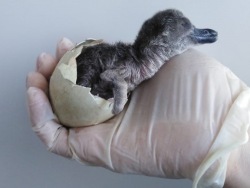Rare penguins are born at the Aquarium

The Primorsky Aquarium has several new additions to its penguin family – chicks have hatched to six pairs of Humboldt penguins. Of two eggs laid by a female penguin, only one is usually fertile, and two chicks born to a pair are a real luck. The Aquarium has been lucky twice.
“There are eight chicks in our flock,” said Ksenya Lyubimkina, ornithologist at the Primorsky Aquarium. “Now the baby penguins are covered with dark grayish down; the juvenile colouration will be lost at three to four months old. When their first molt occurs and new feathers replace the down, the young will bear more resemblance to their parents but they will still lack a banding pattern on the chest typical of Humboldt penguins.”
The chicks grow literally by leaps and bounds – hatchlings usually weigh 70-80 g, and by the end of the first month their weight reaches two kilos! Until three to four months old, just before their first molt, the young will be fed by their parents regurgitating partially digested fish for them. Both mum and dad participate in hatching and raising their offspring – they take turns incubating the eggs and then feeding the chicks.
“The male and female alternate on the nest, and we didn’t notice them having any “duty schedule”, that is, it never happened that one sat on the eggs for two hours, and then the other did it for two hours too,” said Ksenya Lyubimkina. “We saw that one pair’s female spent three days on the nest while another pair’s male – Triton – on the contrary, forced his female – Ryzhaya - onto the eggs, keeping strict watch over an equal sharing of parental duties. Penguins are monogamous – if they form a pair bond, they will build a nest and rear their young with the same mate for their entire lives. Galochka and Krylyshko as well as Nika and Sozvezdye were the first to pair off.”
Penguins are consistent not only in choosing a partner. Once a pair is bonded, the birds start looking for a place to build a nest where they will always brood their chicks.
“The nest is typically constructed in a secluded place; we have niche-caves made for penguins, which, just like in the wild, let the birds feel safe because the offspring are securely hidden behind the parents”, Ksenya Lyubimkina explained. “During this time the penguins fiercely defend their nests from threats, sometimes regarding their usual caretakers as intruders.”
Until three to four months of age, the chicks will live in the nests with their parents. When the down is replaced with a denser plumage, they will start learning to swim in the large pool in the aviary. After the first molt the chicks will become independent and turn from babies that require continuous care into full-fledged members of the Aquarium’s flock.
General information:
Humboldt penguins are classed as vulnerable on the IUCN Red List.
The Primorsky Aquarium has been home to Humboldt penguins since 2018.